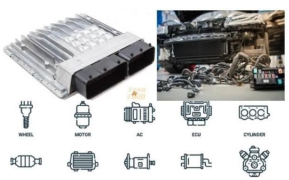
Downloads
Keywords:
Advanced Innovations in Electronic Control Units: Enhancing Performance and Reliability with AI
Authors
Abstract
This paper proposes a methodology for the design of electronic control unit (ECU) hardware units with increased performance and reliability. Today's vehicles are equipped with dozens of ECUs that significantly influence the system's efficiency, reliability, performance, and safety. With the increased complexity of control algorithms and the environmental constraints that automotive systems operate, the robustness and efficiency of the ECUs are of utmost importance.
In this work, an approach is proposed based on combining hardware redundancy, commercial field programmable gate arrays (FPGAs), and artificial intelligence strategies to provide increased redundancy checks and robust control. An additional redundancy is added to the hardware architecture of the ECU to include a parallel hardware unit. The two controlling units operate in parallel. The output of each of them is compared, allowing redundancy checks in the computation of the output variable (oV) of the system. The mathematical model of the ECU depicts the governing equations of the ECU in the form of differential equations, which results in a corresponding state-space configuration. These mathematical models are encoded into the field programmable gate array (FPGA) and processed in hardware, leading to an equivalent software-based implementation.
To analyze the performance of both models within the ECU, an artificial neural network (ANN)-based strategy is proposed. The ANN depicts the governing equations of the ECU in the form of differential equations encoded in the form of sigmoidal functions. To analyze the reliability of the control action in the ECU, the temperature of the system is increased, which leads to a random variation of the system parameters. The variability of the ECU parameters leads to a deviation in the computation of the oV and the corresponding control action. The robustness of the control is determined in such conditions. A control law is determined to guarantee proper control action under variations in the governing equations of the system.
This control law is represented by a simple algebraic equation, which can then be cast in various control strategies, such as look-up tables or fuzzy logic controllers. Several cases are simulated to assess the performance of the proposed control law for the hardware redundancy scheme, for the ANN-based equivalent software implementation approach, and for the additional fuzzy logic controller. The simulation results are analyzed concerning the requested oV and give insight into the performance and reliability of the proposed dedicated ECU design.
Article Details
Published
Issue
Section
License

This work is licensed under a Creative Commons Attribution-NonCommercial-ShareAlike 4.0 International License.

